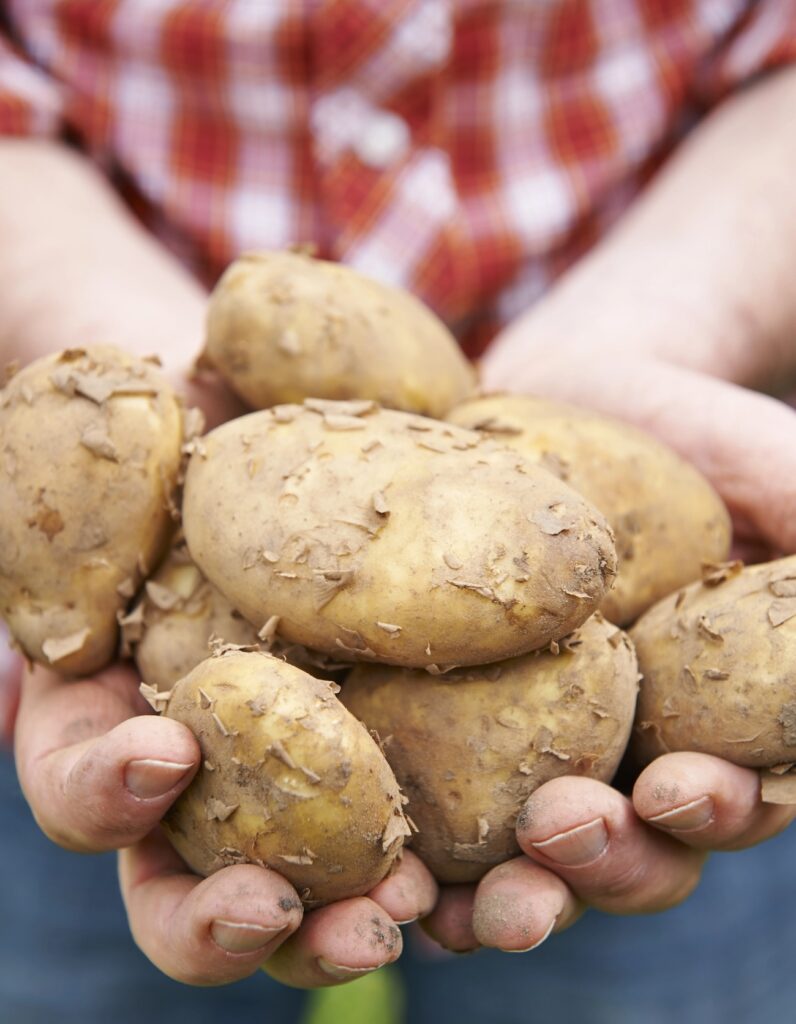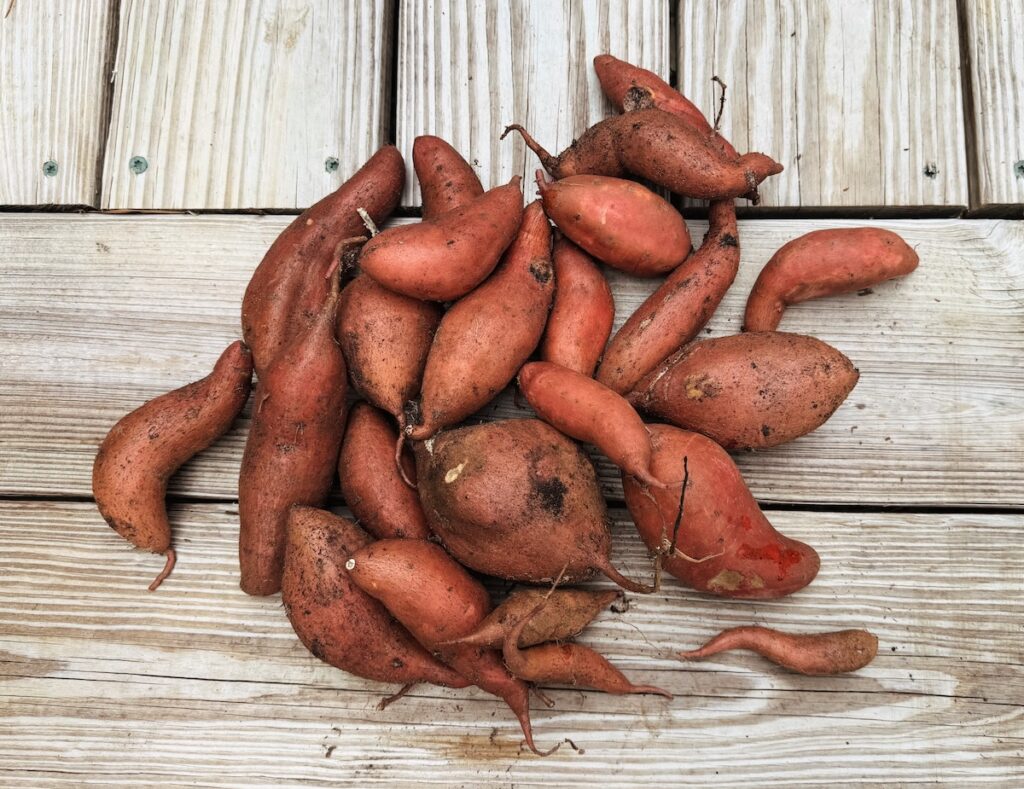How to Grow Potatoes in Containers
Potatoes might not be the first thing that comes to mind with container garden, but they’re surprisingly easy to grow this way. In fact, container gardening can make growing potatoes even more efficient.

Potatoes love growing vertically, often take up a lot of space, and can be susceptible to soil pests and contaminants. By using containers, you can maximize your yield while reducing many common gardening challenges.
How to Grow Potatoes in Containers
Organic gardening expert Laura Randall of Cubit’s Organics shares her top tips for growing potatoes in containers here.
Choose the Right Container
Almost any well-draining, non-toxic container will work, but a tall shape is ideal. Potatoes grow best when they have room to grow upward as soil is added. Some of the best options include:
- Grow Bags – One of the easiest and most effective ways to grow potatoes. These breathable fabric bags improve drainage and aeration, reducing the risk of rot and encouraging strong root development.
- Large buckets – Food-grade buckets or repurposed garbage cans work well. Be sure to drill extra holes in the bottom for drainage.
- Terra Cotta or wooden crates – While visually appealing, these options may dry out faster, so keep an eye on moisture levels.
- Repurposed Containers – You probably have already have something that will work so you don’t have to buy new. Laura’s favorite repurposed container was an antique claw foot bath tub with a layer of stones and brick at the bottom to ensure adequate drainage.
Before planting, clean your chosen container thoroughly and make sure it has adequate drainage holes.
Selecting & Preparing Seed Potatoes
One of the best things about growing potatoes in containers is the variety you can choose from. Potatoes come in a rainbow of colors — red, yellow, purple, and blue — as well as fun shapes like fingerlings.
You can find seed potatoes at local nurseries, gardening events, organic co-ops, or online from reputable sources (see list at the end). If you’re using grocery store potatoes, choose organic ones to avoid growth inhibitors and look for sprouting eyes.
Laura typically grows:
- Russian Blue
- Rose Finn Apple Fingerlings
- Alaska Sweetheart
- A bag of organic red potatoes that sprouted on their own
I’ve also grown a few varieties of potatoes in grow bags in the early spring and late fall. And while this isn’t container gardening, I always save a few sweet potatoes to let them sprout and provide ground cover for my raised beds in the winter. Here’s the harvest from January 2025:

How to Chit & Cut Seed Potatoes
Once you have your potatoes, you’ll need to chit them, which is just getting them to sprout eyes. Putting them in a paper bag or egg carton for a few days should do the trick.
Potatoes can be planted whole or cut up. It’s a matter of personal preference. I cut mine in half. Make sure there is at least one eye per piece and then leave them in a dark spot for the cut to heal over night.
Planting Potatoes in Containers
- Add 4-6 inches of nutrient-rich soil and compost to the bottom of your container.
- Place the potato pieces on top, eyes facing up.
- Cover with another 4-6 inches of soil and water well.
- As the plants grow, continue adding soil to cover the stems, leaving only the top few leaves exposed. This encourages more tuber production.
Potatoes need at least 6 hours of direct sun per day. I usually tuck my containers into an unused corner of the garden, and they still thrive.
Companion Planting
Potatoes grow well alongside beans, cabbage, and corn, but keep them away from tomatoes, raspberries, squash, and sunflowers, which can attract pests or stunt their growth.
Watering & Hilling Up
Keeping the soil evenly moist is key—potatoes don’t like drying out, but they also don’t want soggy roots. Grow bags are especially helpful for preventing overwatering, as their breathable fabric allows excess moisture to escape.
Every two weeks or when plants grow about 6 inches, add more soil around the stems. This is known as “hilling” and helps encourage more potatoes to grow.
When & How to Harvest
Potatoes take anywhere from 2-4 months to mature, depending on whether you planted early-, mid-, or late-season varieties. Once the leaves turn yellow and die back, it’s harvest time!
To harvest:
- Use your hands or a pitchfork (trowels can damage delicate skins).
- If using a grow bag or container, simply dump it out onto a tarp or patio and sift through the soil.
Growing potatoes is a fun and rewarding activity for kids, too—digging for potatoes at harvest time is like a treasure hunt!
Enjoy Your Homegrown Potatoes!
Freshly harvested potatoes taste incredible. Our family loves them on homemade pizza with leeks, in soups, as a simple roasted side dish, or in a classic summer potato salad.
If you’re ready to try growing potatoes in containers, grab some seed potatoes and get started. You might find that grow bags become your new favorite way to grow them!
Where to Buy Organic Seed Potatoes
- Filaree Farm – A certified organic farm specializing in heirloom and specialty seed potatoes with a strong focus on sustainability.
- Wood Prairie Farm – A family-run, organic farm in Maine known for its high-quality seed potatoes and excellent customer service.
- High Mowing Organic Seeds – Offers a diverse selection of organic and non-GMO seeds, including top-tier organic seed potatoes.
- Johnny’s Selected Seeds – A trusted source for organic and conventional seed potatoes with a reputation for high germination rates.
- Eagle Creek Farms (Canada) – A Canadian farm providing unique and heirloom potato varieties grown with organic practices.
- Hope Seed (Canada) – A small, sustainable seed company specializing in heritage and regionally adapted seed potatoes.
More Gardening Resources
Looking for more great gardening ideas? Here are some of our most read articles:
How to Plan a Food Forest in Your Own Backyard
Growing Good Eaters: 5 easy vegetables to grow with kids
The 10 Easiest Vegetables to Grow from Seed
5 Tips for Growing Your Own Vegetable Seedlings
How to Get Your Kids Active in the Garden
Useful Gardening Gifts

Hello, Laura! Thanks for this great article! I think I’ll be able to plant my potatoes really well just by following your process. It seems organized but fun at the same time! Thanks